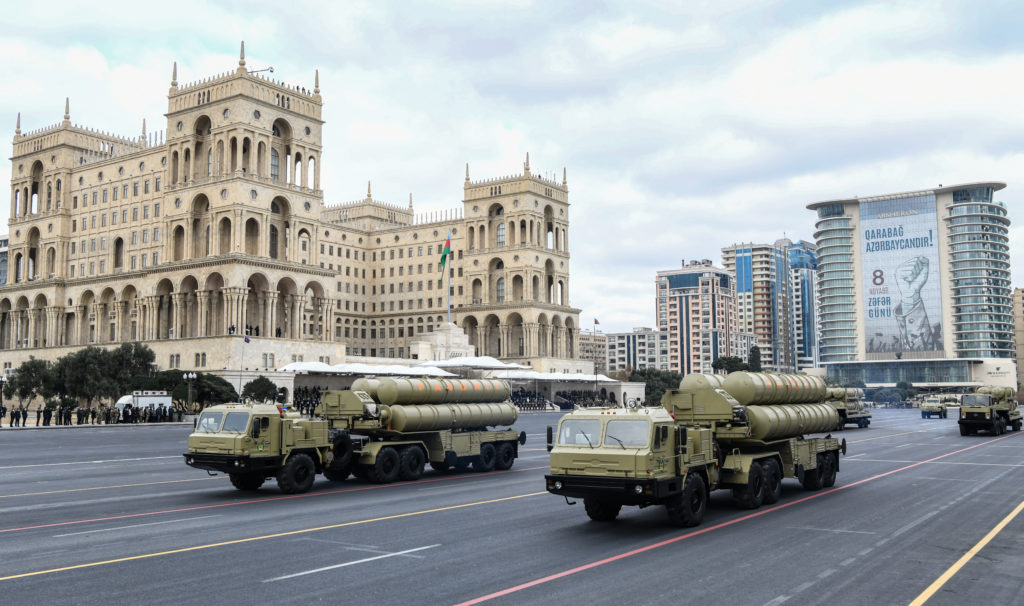Armenia and Azerbaijan agreed on a Russia and Turkey-brokered ceasefire after six weeks of heavy fighting in November, following the Azerbaijani army’s seizure of the strategic city of Shusha (known as Shushi in Armenian).
According to the senior official, Russia encouraged Armenia to use Iskandar missiles and provided material support for their launch, in order to compel Azerbaijan, which was capturing territory at a fast rate, to give the ceasefire a chance.
‘It was concerning for Azerbaijani officials. But a missile defence system operated by the Azerbaijani military, an Israeli-made Barak-8, shot it down’, a senior official told the Middle East Eye.
“An Iskander ballistic missile was launched by Yerevan directly into the capital days before the ceasefire. It was concerning for Azerbaijani officials. But a missile defence system operated by the Azerbaijani military, an Israeli-made Barak-8, shot it down,” the official said.
“Further use of these missiles could really escalate the situation on the ground. And I think, among other things, it convinced the Azerbaijani leadership to go for a ceasefire.”
A senior Armenian military official who has taken part in the war told journalists in November that Yerevan indeed fired the short-range missile at Azerbaijan.
“[It] was used during the war though I will not say where,” Colonel-General Movses Hakobyan said, according to a report by Bloomberg, after he had stood down as head of the defence ministry’s military control service.
Russia also delivered military supplies to Yerevan during the war “as much as their conscience allowed”, he added.
Azerbaijan has an operational land-based version of Barak 8-system with 12 launchers and 75 surface-to-air missiles, which could have been used to take down missiles like the Iskander. The system was acquired by Azerbaijan in 2018 and has been tested.
Video footage, which appeared on social media hours before the declared ceasefire on 9 November, indicated that Armenia launched an Iskandar missile into Azerbaijani territory.
Can Kasapoglu, director of defence research at Turkish think tank EDAM, told MEE that Iskander systems were mobile and Baku was within its range from Nagorno-Karabakh.
“It is quite plausible that Armenians have tried to target Baku with an Iskander as a last resort to put pressure on Azerbaijan for a ceasefire,” he said. “The use of Iskander matches with Armenia’s intra-war deterrence efforts as they were overwhelmed by Azerbaijani technological superiority in the battleground.”
Early in the conflict, the Armenian military targeted Azerbaijan with Tochka and Scud missiles. Kasapoglu suggested it was understandable that Armenia would resort to more advanced models such as the Iskander as its situation became more desperate.
“Of course, using these assets on the civilian population, which the Armenian missiles hit, was a war crime,” he added.
Kasapoglu, who will release a report this week on Armenia’s use of Iskander systems during the war based on open-source information, said his research suggests that Armenia launched the missile 24 or 48 hours before the ceasefire.
“We believe that Russians played a role since the missile command center is jointly run by Armenian and Russian military officers.”
Ilham Aliyev, Azerbaijan’s president, told a group of journalists last week that Armenia had fired several ballistic missiles into Azerbaijani territory, and regional countries were able to track them.
In October, Armenian missiles attacks caused civilian casualties in Azerbaijan’s second-largest city Ganja. Azerbaijan reported that at least two missiles with 300km range landed in districts near Baku.
Both Azerbaijani and Armenian forces have been accused of war crimes and abuses in Nagorno-Karabakh, a disputed mountain territory.
BY THE MIDDLE EAST EYE
THE VIEWS HERE WRITTEN HERE ARE THOSE OF THE ORIGINAL PUBLISHER AND DO NOT HAVE ANY ASSOCIATION WITH THE EDITORIAL POLICY OF THE TRIBUNE.


